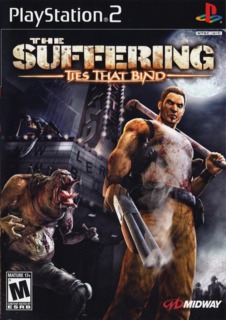TTB retains the doom and gloom of its predecessor while employing some effective gameplay tweaks...
Like any good sequel, the game builds on the story of Torque’s internal prison just as he escapes from the literal lockup that he and his tormentors left so thoroughly soaked in gristle and gore. Even if the player dons his tin halo and guides Torque through the most wholesome and helpful night on the town possible – stopping to guide junkies home, fighting alongside street preachers and desperate mercenaries, and so on – he’ll end up thoroughly soaked in viscera sooner than later. Anyone who played The Suffering knows by now that Torque is his own worst enemy; even the “good” version of Torque was responsible for the death of his wife and child through his criminal past and subsequent association with an unseen ringleader named Blackmore. Those who finish any of TTB’s multiple storylines will learn a lot more about Torque’s relationship with the omnipresent supervillain. Minor spoiler: whether or not a player cares for a particular ending depends on just how much they enjoyed The Sixth Sense, but it’s significant to note just how few first-person shooters contain a plot worth following at all, much less one that throws a nice Shyamalan-style twist into the mix.
So, the original game’s “Am I Evil?” undercurrent returns to find Torque receiving praise from his dead wife for good deeds or props from his gangster mentor for bad behavior. This time, however, those actions add up to much more than shuffled cutscenes as the story draws to a close. TTB’s designers admitted in interviews that most players ignored the “TORQUE SMASH” übercritter into which they could transform, so Surreal wisely added a disposition-specific set of tricks to the creature’s arsenal and rendered a few areas impassible without a little help from the beast within. The changes work well, although I was already very familiar with Torque’s temporary tantrums since ammo was at such a premium under the Hard setting in the first game. And, boy, if you think that experience was tough, TTB’s degree of difficulty ramps up to a shade shy of impossible between Normal and Hard. I was constantly on the run, barrels emptied and Insane-o-meter drained, during several sections of my midnight tour of historic Baltimore. I think that I had to play the street scene outside of the old theatre more than two dozen times – more than any other level in an FPS, in my memory, since Medal of Honor’s hellishly one-sided Snipertown slog – after repeatedly finding myself sliced, gobbled, or burned to death with naught but an empty pea-shooter in hand.
Speaking of spent shells, I really enjoy the resource management aspects of most shooters, when I find myself facing down a slavering horde with only two clips, an RPG round, a ratty voodoo doll, and heaps of practice at circle-strafing. However, I much prefer a limit on the amount of ammo available while keeping the “magic pockets” convention of unlimited cargo capacity intact. Two rifles and a melee weapon are well-and-good for more realistic fare, but I like to keep every toy I scrounge up for fantasy/horror titles. I’m much more forgiving of the designers’ decision to cut out the portable Xombium supply for part two, but backtracking for a taste of pharmaceutical relief was never as difficult as abandoning a beloved sidearm just because a fresh clip wasn’t immediately available.
I really enjoyed The Suffering’s awesomely awful menagerie of restless and resurrected souls, and TTB’s monster manual is just as packed with the stuff of nightmares. The original game’s theme of corporal punishment given earthly form is deftly overwritten by the ills of city living (overdoses, gunplay, muggings gone wrong, victims of arson, and so on) with only two retreads, but the Slayers and Mainliners were iconic enough that their return made perfect sense. The new Gorger was big, loud, and downright gross in both its eating habits and its tendency to explode when poked, while the reimagined Marksman and brand-new Suppressor and Isolationist were creepy and powerful enough to evoke real dread.
Never mind all the cussing and disembowelment; grownups and survival horror fans alike should be used to such aspects of games that don’t skimp on their “M” rating. However, I still recommend taking a break from this game every few hours. Not to seem overweening, but TTB leads the player through one dark, depressing, despairing scenario after another. I understand that I just described a number of video games (the aptly-named Doom series comes to mind, of course, as well as a few others), but The Suffering really sports a seriously heavy vibe in its storyline and level design. I would play for an hour or two, then head out into the sun for a bit, then return for another round. Technically, the first title isn’t required for TTB to work, but, come on, quit dithering and buy them both, if only for the sake of narrative continuity. Given both games’ genuinely creepy atmosphere, army of creative assailants, and Torque’s unique good/evil characteristics, Ties That Bind is worth every penny and minute spent playing.

